SmartAgents is your AI-powered teammate inside Smartlead, designed to automate every part of your repetitive go-to-market (GTM) process. It allows you to focus on what matters most, closing deals, while SmartAgents handles research, outreach, analytics, and repetitive tasks across your workflow.
With SmartAgents, you can:
Automate repetitive sales, marketing, and operational tasks
Execute actions in Smartlead and connected tools (Slack, Airtable, Google Sheets, and more)
Analyze performance and take proactive action without manual intervention
Receive real-time alerts when something needs your attention
You can build SmartAgents from scratch, no coding required.
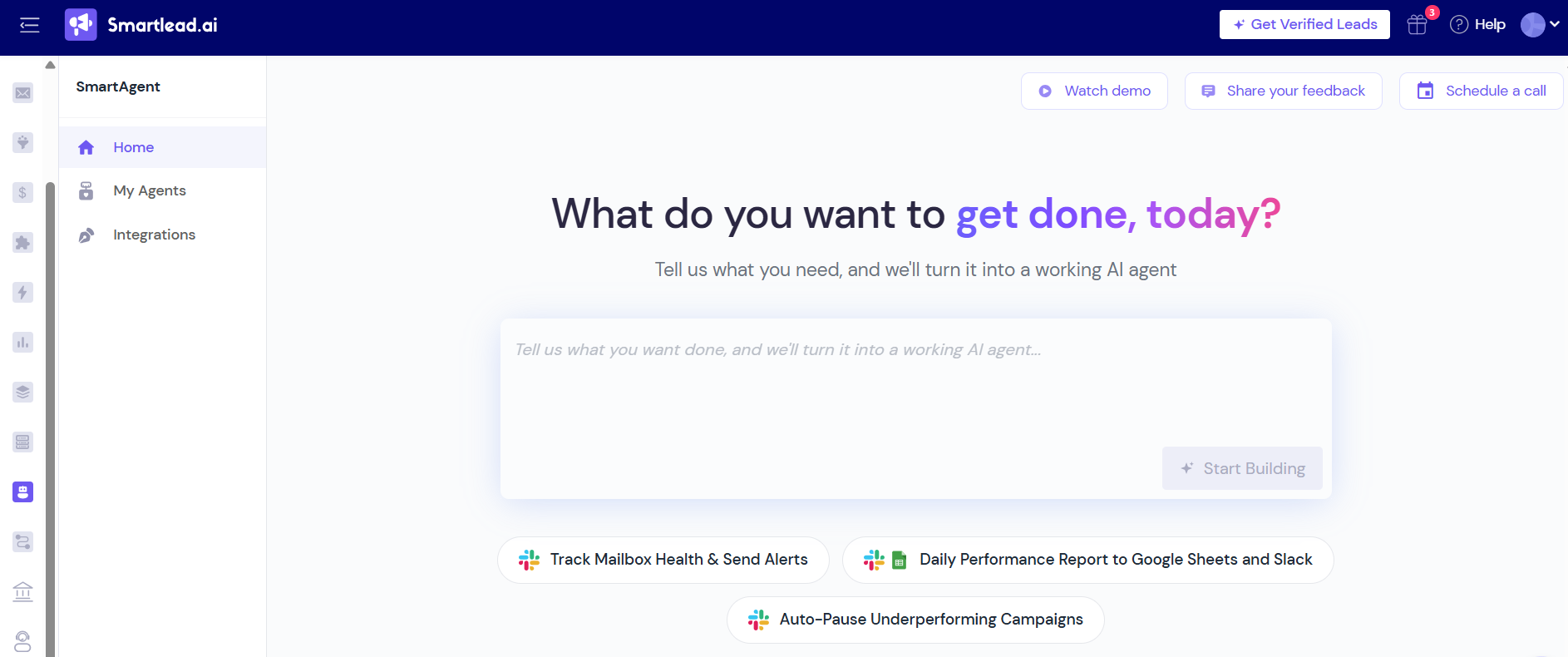
SmartAgents is an AI-powered, fully customizable assistant built right into Smartlead. It helps you automate every stage of your go-to-market (GTM) process, from lead research and outreach to mailbox health, analytics, and even closing deals.
SmartAgents is your AI-powered teammate inside Smartlead, designed to automate every part of your repetitive GTM process so you can focus on what matters, which is closing deals.
SmartAgents is a modular AI-driven assistant powered by:
Triggers – Schedule-based, event-based (e.g., lead reply), or manual runs
Actions – Internal Smartlead operations and external tool integrations
Context – Your business rules, ICP, and historical campaign data
Logging – Every run is recorded so you can review and refine performance
You can run a single SmartAgent or build a network of specialized agents to cover your full GTM workflow.
Before creating and using SmartAgents, we recommend connecting your tools.
Go to the Integrations tab.
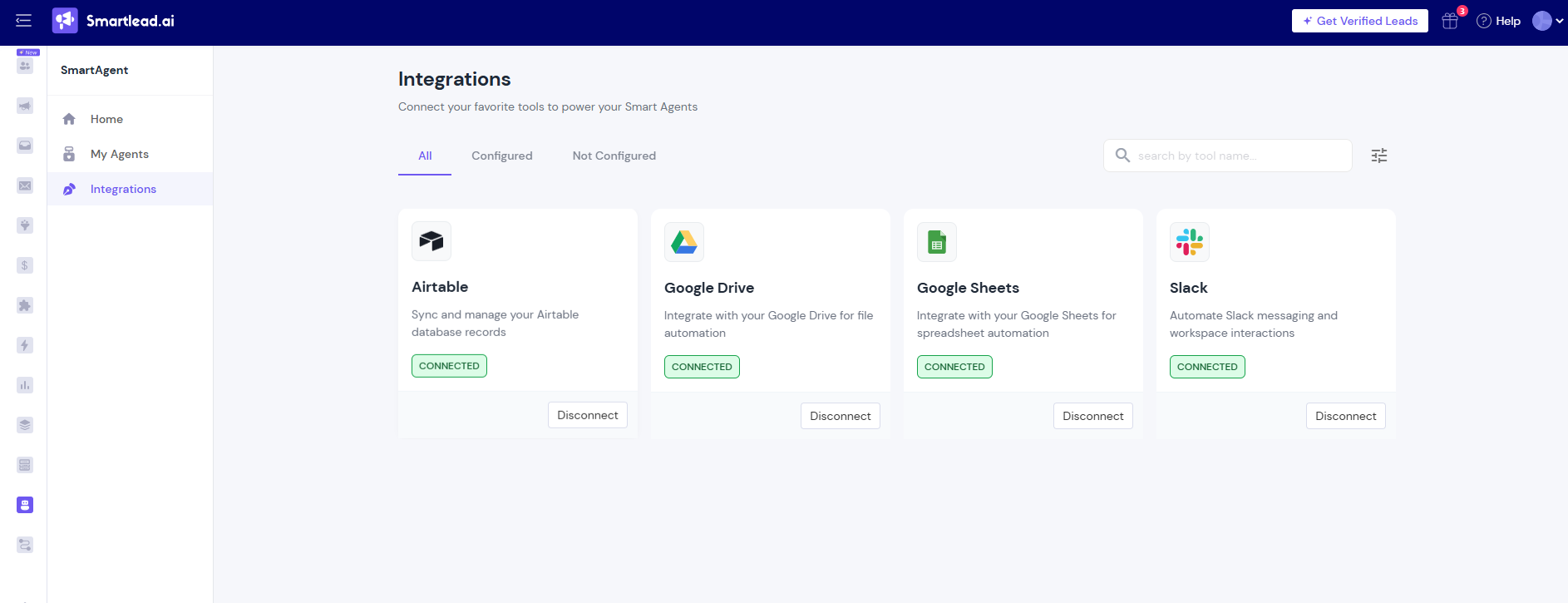
Click on Connect, and then click on Allow Access to connect your tools.
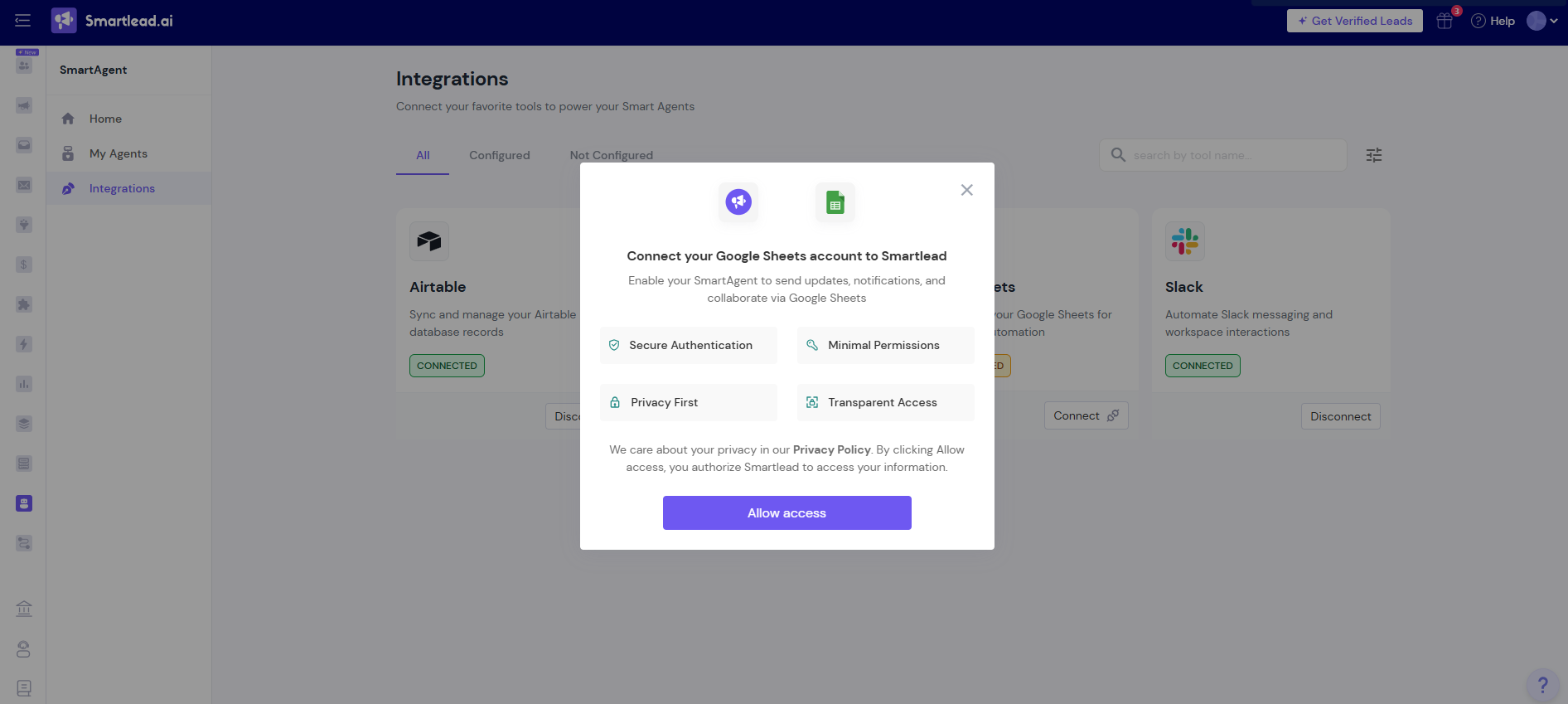
Authorize each tool (Slack, Google Drive, etc.) as prompted.
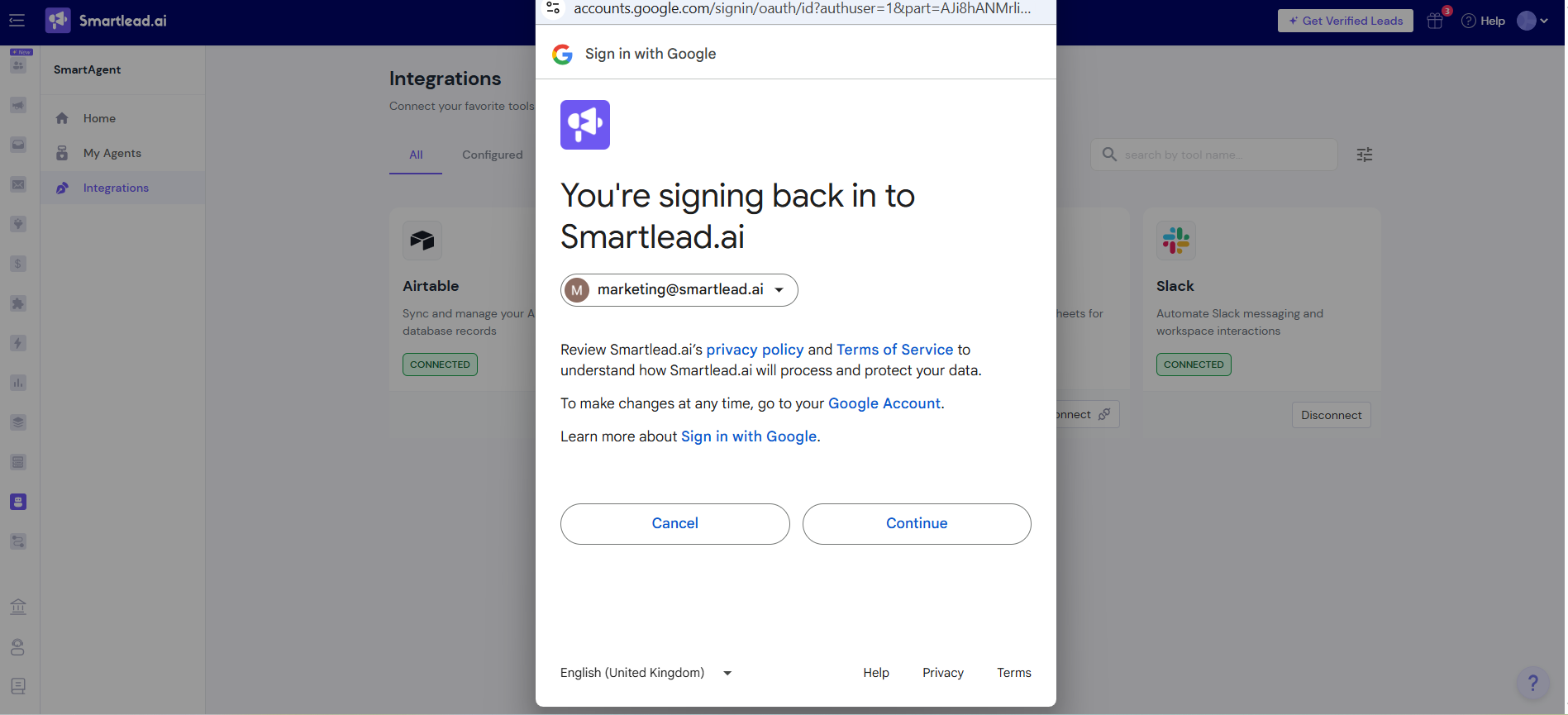
Once connected, you’ll see the status updated for each integration.
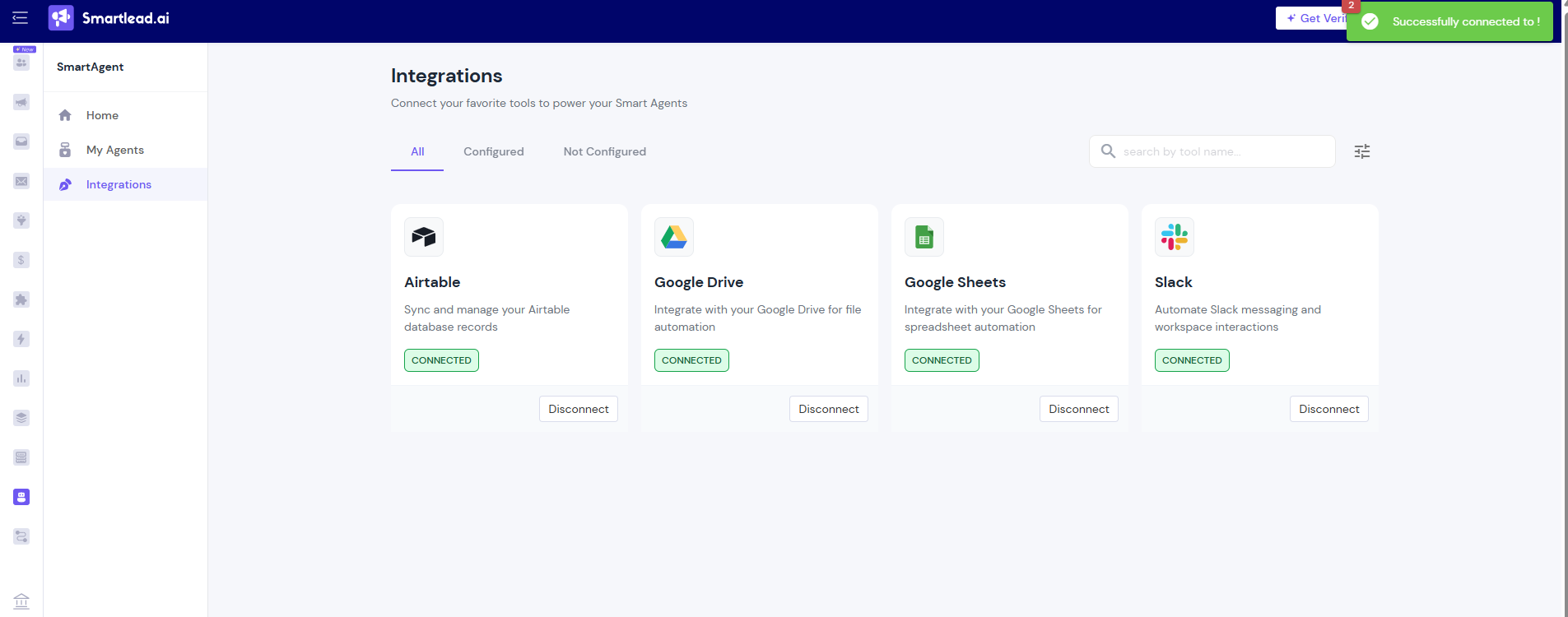
Note: Connections are one-time. Once a tool is linked, you don’t need to reconnect.
On the left panel of Smartlead, click SmartAgents.
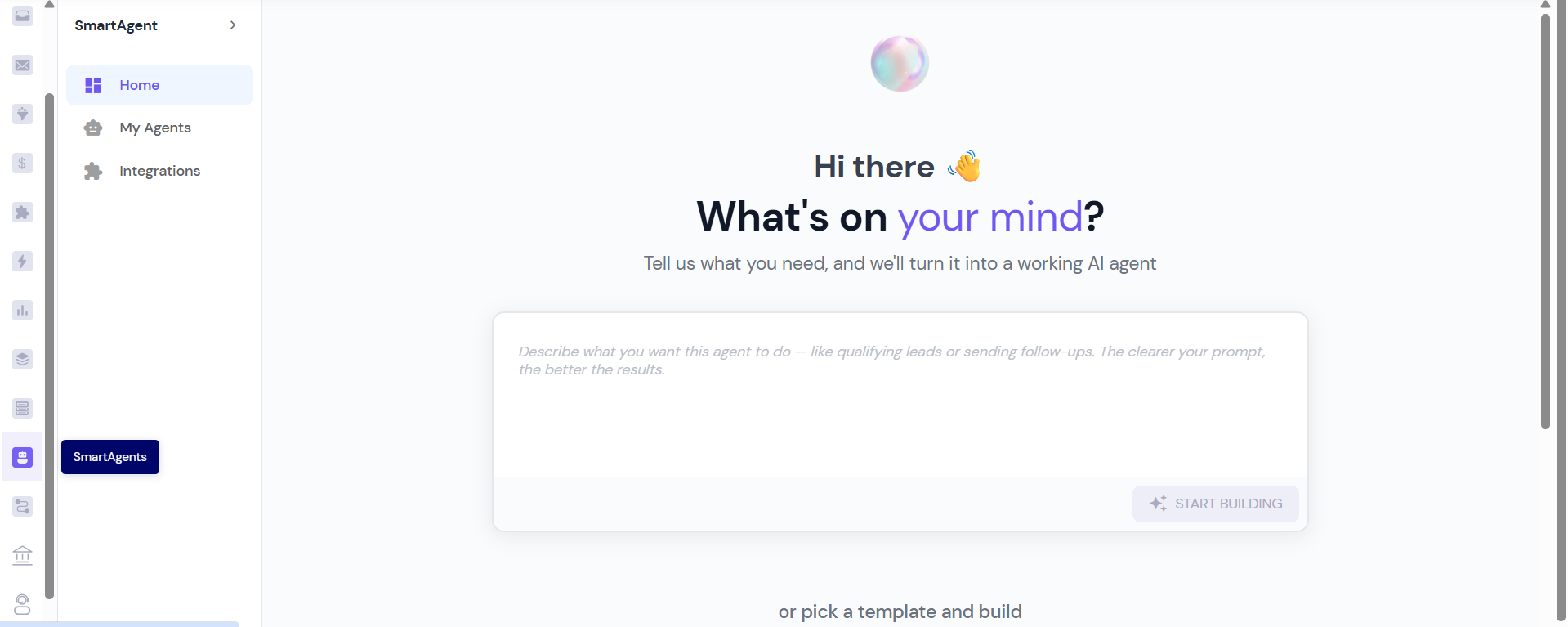
You’ll land on the SmartAgents page, which has three tabs:
Homepage – Where you write prompts to build agents
My Agents - Your agents list
Integrations – Connect external tools (Slack, Airtable, Google Sheets, Google Drive, etc.)

Go to the Home tab. At this stage, you can start from scratch. For that, describe the task you need the Agent to perform.
Type your task in natural language.
After typing the prompt click on Start Building.
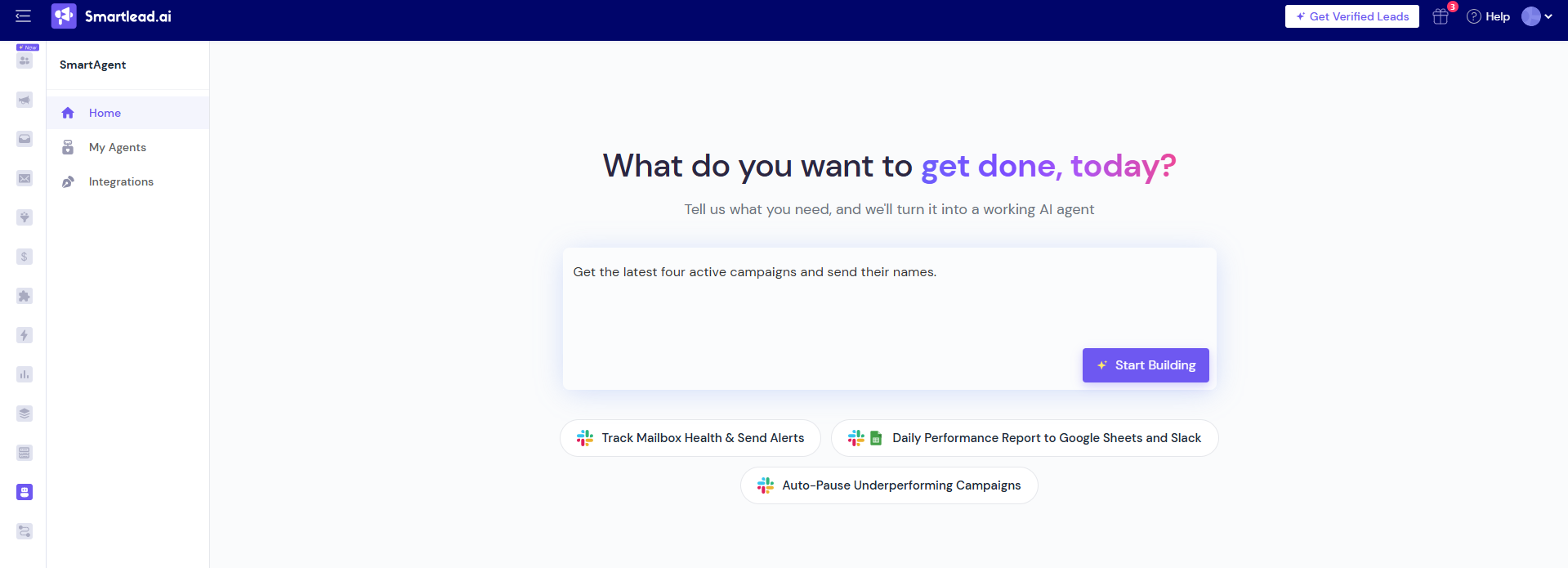
Answer any clarifying questions from the AI. This ensures your agent fully understands the task.

Refine your prompt until you’re satisfied with the blueprint. Click Build Agent to proceed. If you want to change anything, you can continue typing in to fine-tune your agent.

After building the agent, you can see in the example image below, SmartAgents provides live updates on the integrations required for your Agent to perform optimally.
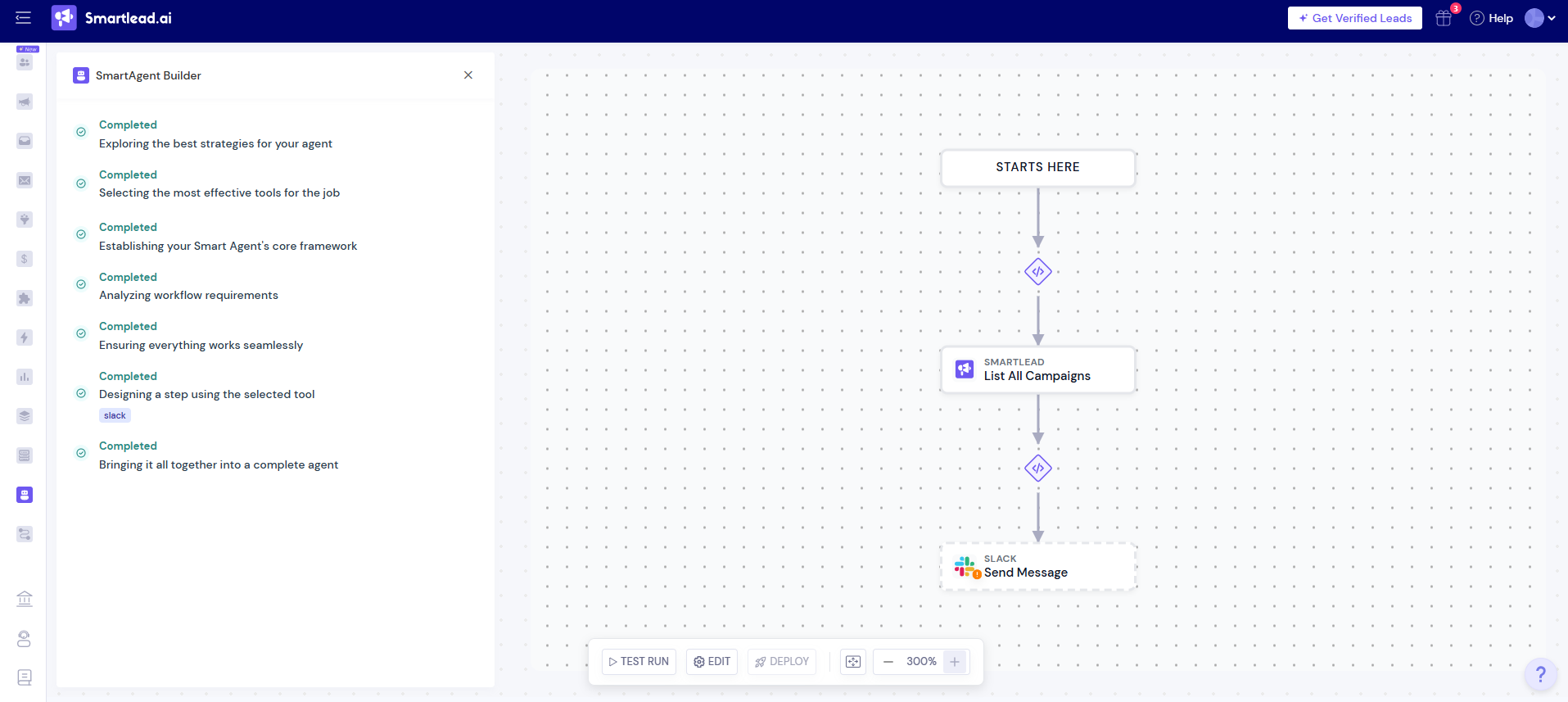
Now that the agent has been created, you can see it on the right side, but you can also see that there are few configurations that are needed.
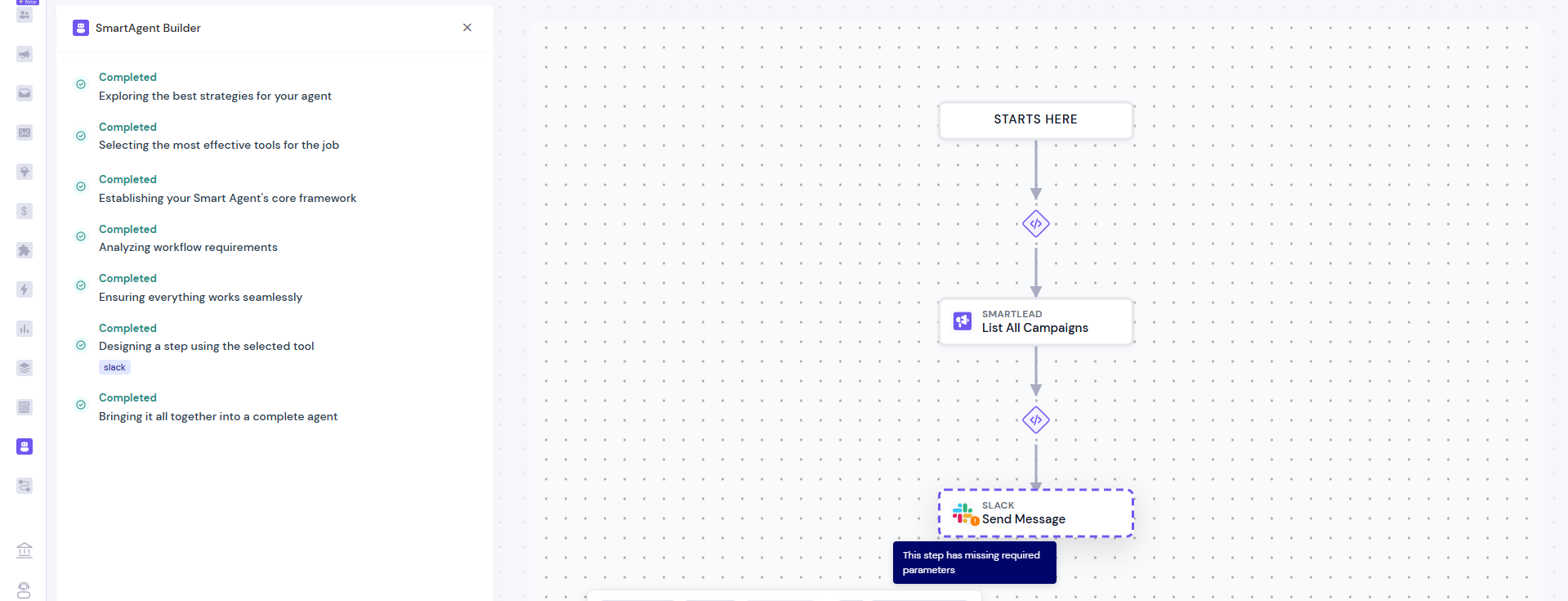
So whenever you see this amber color exclamation, that means, the configuration is needed.
Link your Slack, Airtable, or other platforms if they aren’t already connected.
This is a one-time setup, once you’ve linked your tools to Smartlead, you won’t need to repeat this step.
Once your SmartAgent is generated, you can see the entire workflow and understand how each step connects.
In this particular step, now in between the two steps, you will also see there is a connector step.

Step Connections
In the connection steps, you can see how the logic flows. The logic between these two steps shows how the agent iterates over campaigns and executes tasks sequentially.
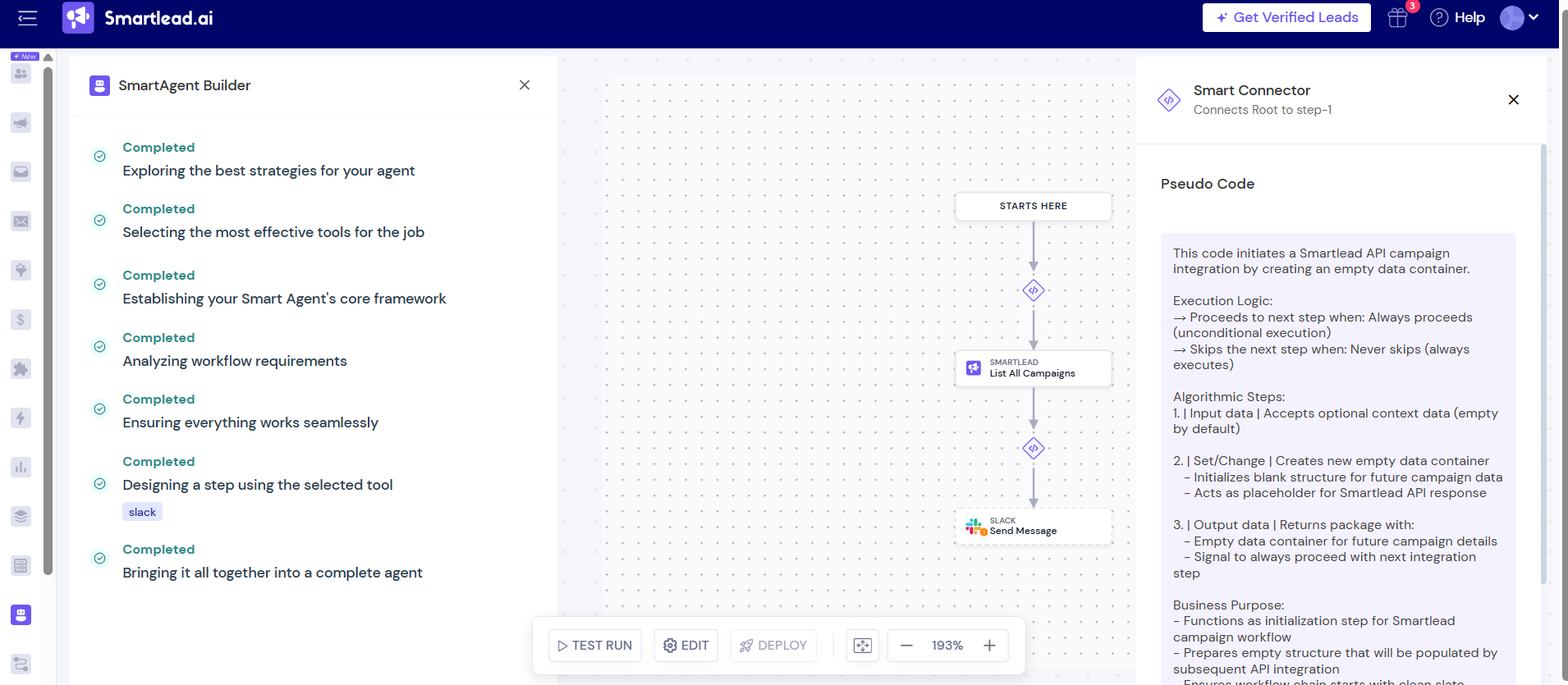
Each step is linked logically. For example, Step 1 may pull campaign data, and Step 2 formats and sends it to Slack.
You can click on any step to view or modify its configuration.
Click on the step you want to view or modify.
Click on Edit Connection Logic.

Describe the changes you want to make.

Save the configuration.

If you want to revert to the original settings, click Reset to Default.
Changes are reflected immediately in the workflow preview.
Tip: Review the workflow visualization carefully. This ensures the agent performs tasks exactly as you want before deployment.
Run a simulation to see exactly how the SmartAgents will behave.
If results aren’t as expected, refine prompts, logic, or settings.
Test until you are confident in the output.
If you’re not satisfied with the test run results, provide appropriate feedback, and the simulation will rerun with the provided inputs.
Set triggers (schedule, timezone, whether you want to skip weekends, or event-based triggers) for the SmartAgents to perform the action.
Once deployed, you will be redirected “My Agents List page. You will see all of the agents inside it and also you have an ability to disable and enable it anytime.

You also have three other options.
Edit Agent
Run Logs
Delete Agent
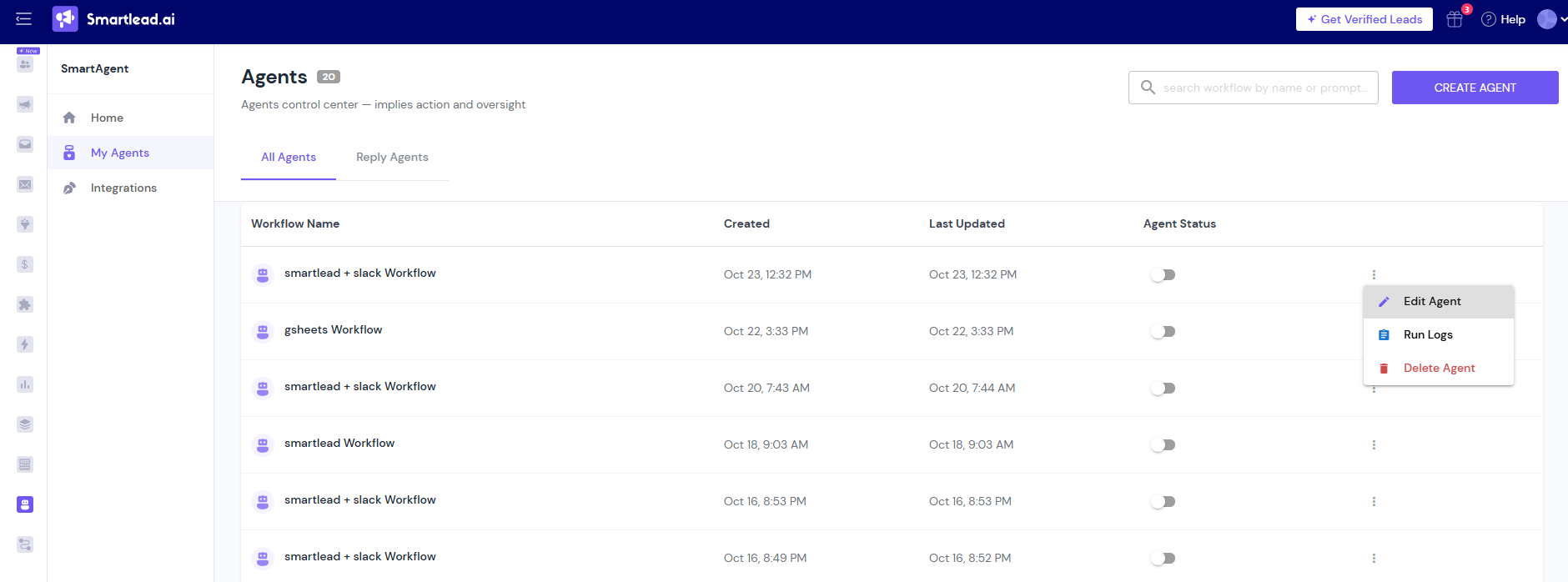
You can edit the agent anytime to update outputs, integrations, or workflow logic.
Check run logs to monitor agent performance. (In example below these are cancelled, but if anything is, has run, you will see that these are already there.)

As your agent works, you get status updates in real time, allowing you to see exactly what’s happening in each step of the workflow.
Connect Slack
In Smartlead, navigate to SmartAgents → Integrations tab.
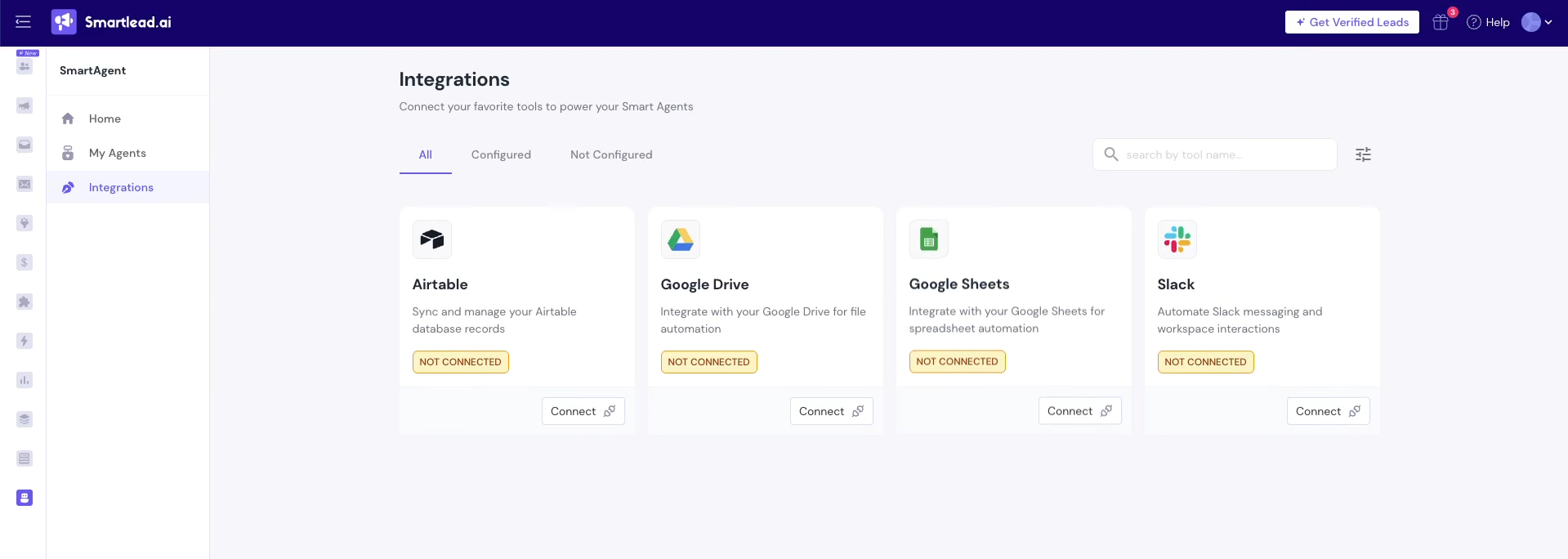
Click Connect next to Slack and authorize access.

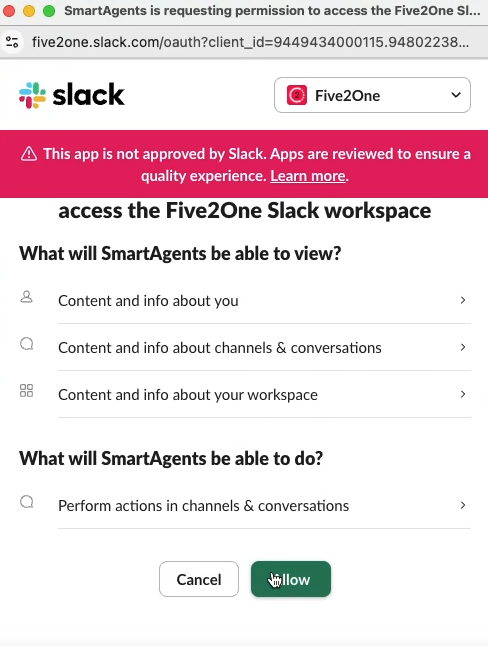
Go to the Slack channel that you want to use for your updates or any messages you want to receive. Type /apps or /writeapps to see apps available in that channel.
And then, you will see that apps, all the apps are available. For this channel, type in smart agents, and then you will see this smart agents, app.

If it is not added, you will see an Add button. Just click Add. (In the example screen above, since it is already added, the View option is appearing.)
Once you do that, you are done. You are good to go with this channel to receive any messages.
In the Integrations tab, click Connect for each tool you want to link.
Sign in and grant permissions when prompted.
Once connected, you only need to do this once unless you manually disconnect
Note: If Google shows "App not verified," click Advanced and proceed to the app anyway. This is normal for apps under review. We are getting it reviewed by Google and so just give access to this. Similarly for Airtable.
Go to SmartAgents → My Agents to view all your created and deployed agents.

From here, you can:
Edit prompts or workflows
Check run logs
Pause or delete an agent
Toggle draft/live status

You can also change the output destination. If an Agent is in draft use the toggle to make it live.
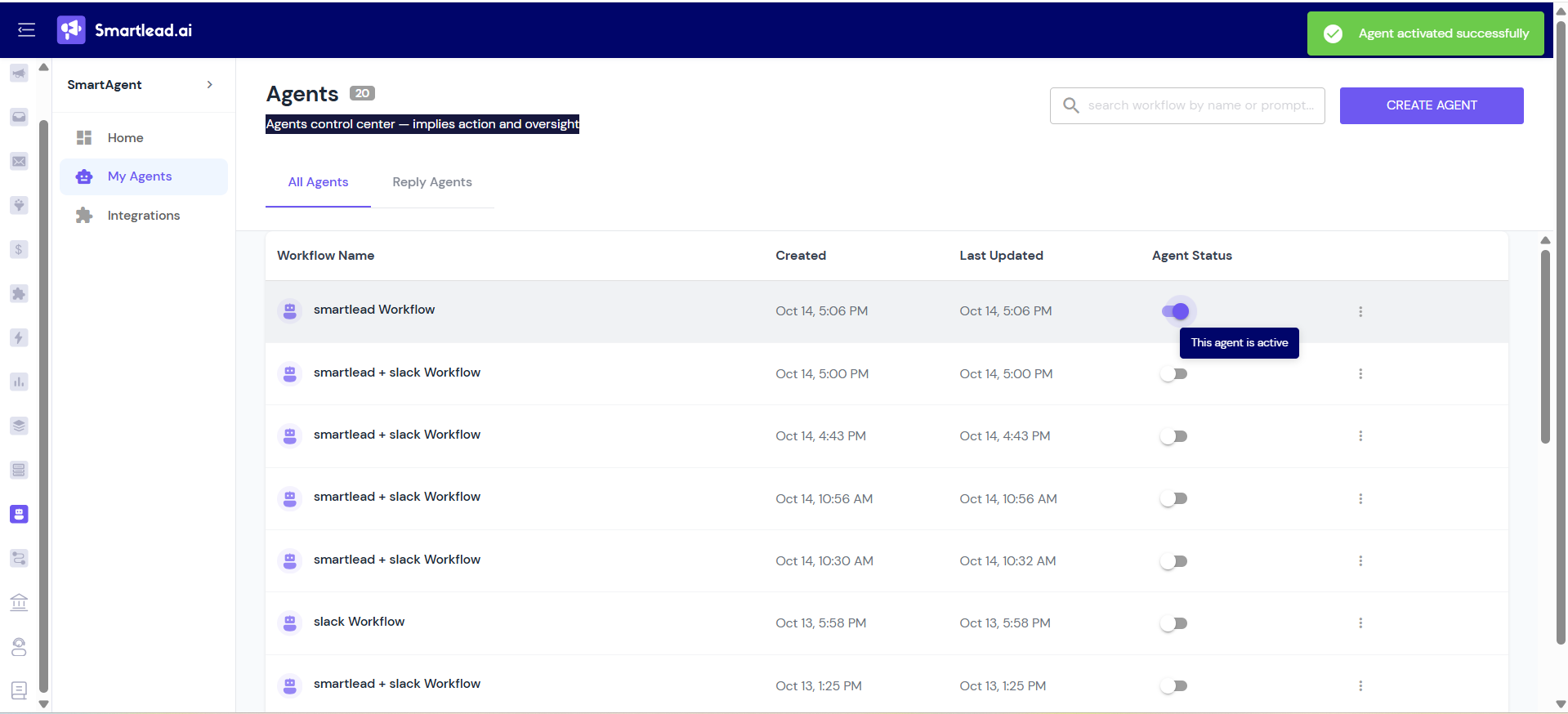
Here are some best practices to follow for using SmartAgents to make it work perfectly:
Be precise: Be as detailed and comprehensive as you can be; vague prompts create vague actions
Start small: At first, start with automating one high-impact process first and scale from there
Review logs: Regularly check run history for accuracy
Automate alerts: Have SmartAgents notify you of discrepancies or anomalies across your Smartlead workflow
Chain workflows: Use multiple SmartAgents for full-funnel automation
Watch the full step-by-step video guide: SmartAgents Walkthrough Video
See exactly how to create, test, and deploy your SmartAgents from start to finish.
SmartAgents are AI-powered assistants inside Smartlead that help automate your GTM (Go-To-Market) processes. They perform repetitive tasks like collecting campaign data, sending Slack reports, and syncing with external tools, all without manual effort. You simply describe what you want in plain English, and SmartAgents build and run the workflow for you.
You can find SmartAgents in the left panel of your Smartlead dashboard.
Click on SmartAgents, and you’ll see three tabs:
Home – Create or edit your agent using prompts.
Integrations – Connect tools like Slack, HubSpot, or Google Sheets.
Templates – Use ready-made agent templates.
You can connect several external apps, including:
Airtable
Calendly (Coming soon)
HubSpot (Coming soon)
Slack
Google Drive
Google Sheets
Simply click Allow Access, grant permissions, and your integration will be activated.
Once connected, the tool remains linked unless manually disconnected.
Go to the SmartAgents → Home tab.
Type your task in natural language, e.g., “Get the latest four active campaigns and send their names to Slack.”
The system may ask clarifying questions — answer them to refine the logic.
Click Build Agent to start the creation process.
Review the preview flow and make adjustments if needed.
Clarifying questions help the AI understand your task better before building the agent.
For example, if your prompt is “Send campaign details,” SmartAgents might ask what details to include.
The reasoning step shows how your workflow logic connects, from Step 1 to Step 2 and beyond.
Here, you can:
Adjust logic and formulas
Add or remove steps
Configure thresholds and metric calculations (e.g., reply rate = reply count ÷ contacted leads)
Change output formats (Slack message, Airtable record, etc.)
Yes.
You can click any step in the flow to:
Modify configurations
Add new logic
Change data sources or destinations
Changes are reflected immediately in the workflow.
To connect Slack or other tools like Google Sheets, Airtable, or Google Drive to SmartAgents:
Navigate to SmartAgents → Integrations tab in Smartlead.
Click Connect next to the tool you want to link (e.g., Slack).
Authorize access by signing in and granting permissions when prompted.
For Slack:
Go to the Slack channel where you want to receive updates.
Type /apps or /writeapps to view available apps.
Search for the SmartAgents app.
If not added yet, click Add to enable it in the channel.
Once connected, your SmartAgent can send messages or data to the selected channel or tool.
Note: Connection is a one-time setup. Once linked, you don’t need to reconnect unless you manually disconnect the tool.
You can perform a test run to see your SmartAgent in action.
Example: When connected to Slack, your agent can instantly post campaign names or reply rates to the selected channel.
If results aren’t correct, refine your logic and test again.
Yes!
You can modify things like:
Adding new fields (e.g., reply rate)
Changing formulas (e.g., reply count ÷ contacted leads)
Adjusting display formats for reports
All edits are visible instantly in the workflow preview.
In Smartlead, go to SmartAgents → Integrations tab and make sure Slack is connected.
Go to your SmartAgent workflow and click on the Slack step.
Choose the Slack channel where you want to receive messages (for example, “#smartagents-demo”).
Click Save to finalize the setup.
You can then run a test trial to confirm that your SmartAgent sends updates to the selected channel.
If the Slack app is not added to the channel, you can add it by typing /apps or /writeapps in Slack, then searching for the SmartAgents app and clicking Add.
Run a test trial inside the workflow builder.
The test will show a live output (e.g., a Slack message or campaign data).
If it looks good, you can proceed to deploy the agent.
When deploying, choose your preferred schedule:
Daily
Weekly
Monthly
Specific time (e.g., 9:00 AM)
You can also skip weekends or choose your timezone before saving.
Yes, anytime.
You can change integrations, prompts, or output destinations.
For example, you can switch from sending reports to Slack → uploading them to Airtable.
Go to SmartAgents → My Agents to view, edit, or pause your agents.
Visit Run Logs under My Agents to see:
The status of each run (success or error)
Timestamp of execution
Connected apps and outputs
If there’s an issue, you can fix and re-run your SmartAgent.
Yes.
As your SmartAgent works, you’ll get live status updates for every step in the workflow.
You can monitor what’s happening in real time.
If your SmartAgent fails or shows an error during execution:
Check that all your integrations (Slack, Airtable, Google Sheets, etc.) are properly connected.
Review the workflow logic and configuration steps in the Reasoning Step to ensure everything is set correctly.
Run a new test simulation to see if the issue persists.
If the problem continues, reach out to the Smartlead Support Team directly via chat for assistance.
Currently, agents can’t be shared directly, but you can duplicate or rebuild them using the same prompt.
Team sharing and cloning features are coming soon!
Yes. SmartAgents leverage your historical campaign data, ICP details, and engagement metrics to make smarter, data-backed decisions over time.
It’s best to review them every few weeks or after significant changes in your GTM strategy to ensure they stay aligned with your current goals and workflows.
Definitely! You can monitor agent performance through Run Logs in the My Agents tab. Logs show execution status, timestamps, errors, and more for full transparency.
Yes. You can schedule a call with our team through the Schedule a Call option found on the SmartAgents Dashboard. This lets you share detailed feedback or discuss your suggestions directly with our experts.
Got stuck or have questions? We’re here to help!
Reach out to our Support Team directly via chat.
Or, submit your query using the Feedback form, our experts will respond within 24 hours.
Want to share detailed feedback? Click on the Schedule a Call option in the SmartAgents Dashboard to discuss your suggestions directly.
The more context you share, the faster we can help you find the best solution!